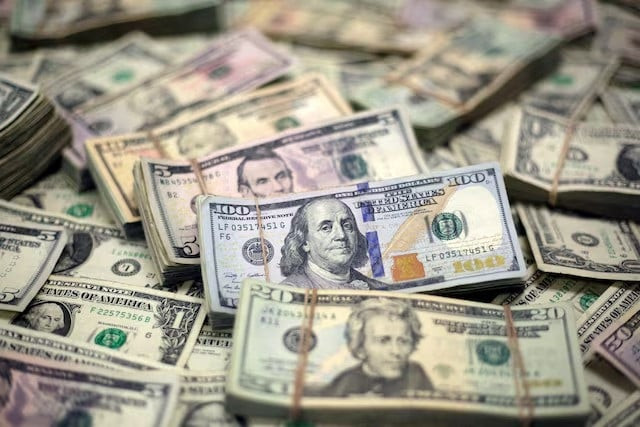USD exchange rates today: Rupee makes modest gains
The rupee saw slight dips against the dollar but managed some gains against the euro, trading at Rs 298.30.

The Pakistani rupee saw a slight improvement against the US dollar in the inter-bank market on Monday.
The buying price for USD reached Rs 277.25 while the selloing price also dropped to Rs 280.
Last week, the rupee had continued its positive trend, closing below the 278 mark for the first time in over five months.
The British pound was trading at Rs 347.95 for buying and Rs 351.40 for selling.
Meanwhile the Euro was bought at Rs 298.30 and sold at Rs 301.25.
Meanwhile, among Gulf region currencies, the Saudi riyal traded at Rs 73.50 for buying and Rs 74.20 for selling, while the UAE dirham was bought at Rs 75.20 and sold at Rs 75.95.
Other notable rates include the Australian dollar at Rs 181.50 for buying and Rs 183.40 for selling, and the Canadian dollar at Rs 200.50 and Rs 202.50, respectively.
Premium currencies such as the Omani rial, Bahraini dinar, and Kuwaiti dinar continued to hold their higher values.
The Omani rial was bought at Rs 715.10 and sold at Rs 722.25, while the Bahraini dinar stood at Rs 728.45 for buying and Rs 735.70 for selling.
The Kuwaiti dinar topped the chart, trading at Rs 889.15 for buying and Rs 898.00 for selling.

Pakistan fluctuations in its exchange rate are influenced by several factors.
This mainly focuses on seven key variables, aside from the exchange rate itself.
These variables are exports, imports, stock price index, foreign reserves excluding gold, industrial production, wholesale price index, and money supply.
It is believed that these seven factors significantly impact the exchange rate.
Previously, Pakistani traders are increasingly turning to futures markets to exchange US dollars, earned through exports, for rupees, amid expectations that the domestic currency will further appreciate.
This comes ahead of the International Monetary Fund (IMF) Executive Board meeting, scheduled for September 25, to approve a $7 billion loan programme for Pakistan.
The increased supply of US dollars in the interbank market has helped strengthen the local currency, with the rupee appreciating by Rs0.07 on Friday, reaching a five-and-a-half-month high of Rs277.84 against the US dollar, according to data from the State Bank of Pakistan (SBP).
Over the past eight consecutive working days, the rupee has gained Rs0.86 against the dollar.
Meanwhile, gold prices in Pakistan surged to a record high of Rs272,000 per tola (11.66 grams), increasing by Rs3,500 in a single day, in line with the global trend.
In international markets, gold crossed the $2,600/ounce threshold for the first time, reaching an all-time high of $2,612.
Speaking to The Express Tribune, Hassan Haider Naqvi, a senior analyst at Icon Management, said that the premium on the rupee-dollar exchange rate over the two-month forward counter dropped to Rs3.25/$, compared to Rs4-4.5/$ just days ago.
Exporters are offloading their dollar holdings to avoid potential losses as premiums continue to shrink.
Naqvi projected that the rupee could strengthen to Rs270-275/$ over the next couple of months, supported by a significant drop in global oil prices around $20 per barrel in recent weeks and expected inflows from the IMF once the new 37-month Extended Fund Facility (EFF) is approved.
He added that funds from other multilateral and bilateral creditors are also likely to be unlocked.
However, Naqvi noted that the sustainability of the rupee's gain remains uncertain, depending on future developments related to the IMF programme and global oil price trends.
He suggested that inflation reduction, the current account surplus, and the real effective exchange rate (REER) all indicate potential further appreciation of the rupee.
Nevertheless, he did not rule out a gradual return of pressure on the rupee, estimating it may settle between Rs270-280/$ by the end of December 2024.
Adnan Agar, Director of Interactive Commodities, said that the global demand for gold has increased following the US Federal Reserve's decision to cut interest rates by 50 basis points this week, double the expected 25 basis points.
"The steeper rate cut has greatly boosted gold prices," Agar noted.
He added that the escalation of geopolitical tensions in the Middle East, particularly with
Lebanon becoming involved in the conflict, has also supported gold prices.
Agar predicted a short-term correction of $80-100/ounce but said a rise above $2,700/ounce is not out of the question in the current gold boom cycle.
He cautioned that a larger correction of $500-600/ounce is overdue, as gold has surged to over $2,600/ounce from around $1,800/ounce a year ago.
Future gold price trends, Agar added, will depend on upcoming US job data and the US presidential election in November 2024.



















COMMENTS
Comments are moderated and generally will be posted if they are on-topic and not abusive.
For more information, please see our Comments FAQ